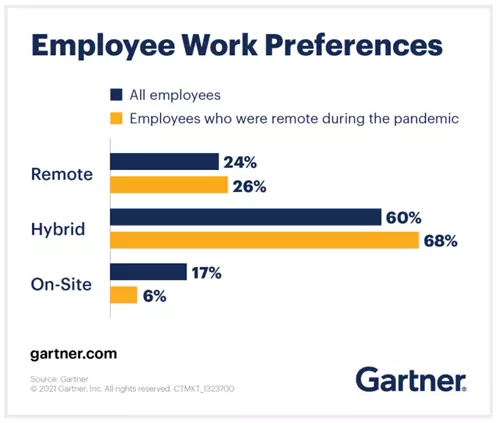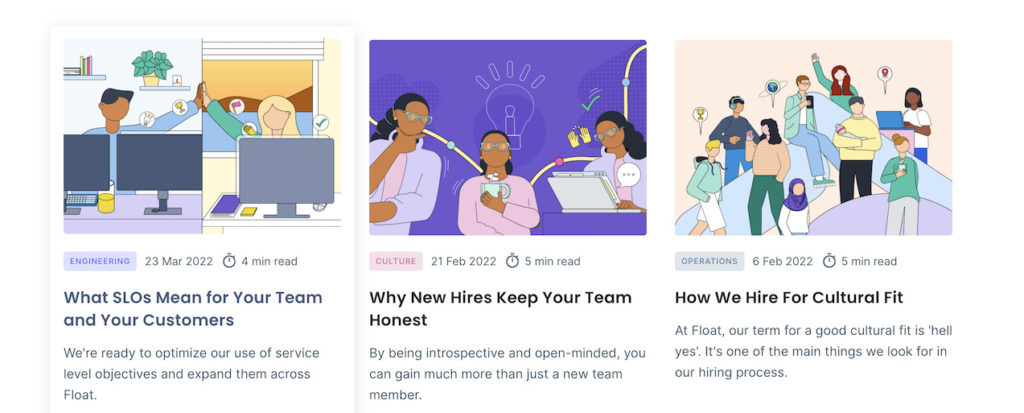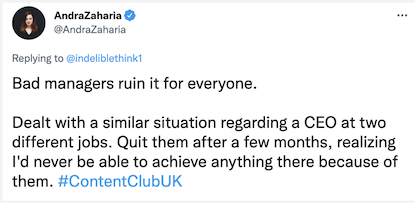7 Ways to Motivate and Retain Top Talent
Elise Dopson | WorkRamp Contributor
View bioLearning Tips Straight to Your Inbox
Employees power your business. Without them, you’d have a hard time achieving your goals. (You’d likely feel stressed when managing all of their hats solo, too.)
But building a strong workforce is only half the battle. Some 63 percent of businesses think retaining talent is harder than hiring new employees. And considering it costs twice their annual salary to replace a single team member, employee retention is a pain point for many managers.
Here’s the silver lining: 52 percent of voluntarily exiting employees said that their manager or organization could have done something to prevent them from leaving their job.
So, what’s the secret to motivating your employees and convincing top talent to stick around for the long haul? Read on to find out.
In this post:
What motivates employees to stay?
It’s easier to retain top talent when you know their motivation behind staying in a job. So, what truly motivates employees to stay, and how can you use these motivating factors to improve employee retention?
- Learning and development (L&D) opportunities
- Feeling understood
- Flexible working options
- Autonomy
- Perks that are actually useful
- Being kept up to date with company info
- Strong leadership
1. Learning and development opportunities
“One of the biggest reasons an employee leaves the company is stagnation or the impossibility of moving up the organizational pyramid,” says Maciek Kubiak, Head of People at PhotoAiD.
“It is essential that key personnel have clear career development perspectives and that the company accompanies them, guaranteeing them the practical possibility of reaching new responsibilities.”
Upskilling—particularly in an area that serves employees better at work—is beneficial for both team members and employers. Not only does the business benefit from extra skills and knowledge, but employees also are rewarded for it, be that through recognition or salary increases.
It’s no wonder Gallup reports that 48 percent of employees would switch to a new job if it offered skills training opportunities.
Learn more about how learning and development contribute to employee engagement.
2. Feeling understood
Employees are much more likely to leave an unhappy workplace than one they enjoy. That’s why Paola Accettola, Principal and CEO of True North HR, says: “To effectively motivate and retain talent in your company, it is first important to understand where their motivation comes from.
“While company structure should operate on a top-down model, and motivation should be from the bottom-up. Each person is different, so HR managers need to understand the employee’s needs from a human perspective over how the company would benefit.
“Understanding each individuals’ needs would help them succeed in the long run. This can include increased mental health support, extra paid time-off, and increased salaries to match their workload.”
In order to identify and retain top talent, businesses need to focus on creating a positive work environment and offering competitive benefits. Employees want to feel valued and appreciated, so it’s important to make them feel like they are a part of the team.”
—Jennifer Hartman, HR Staff Writer, Fit Small Business
3. Flexible working options
The COVID-19 pandemic has changed the way most employers think about work. More people now work remotely than ever—something managers previously disregarded as an option, never mind the “new norm.”
Yet the shift in work location is anything but temporary. Research shows that 43 percent of employees think the main reason for increased productivity is flexibility in working hours. Other top answers included less (or no) time commuting, and a change in physical space—both of which are possible with flexible working.
Not convinced to go fully remote? The hybrid approach still goes a long way in improving employee satisfaction, and therefore, retention. Some 60 percent of all employees prefer a mixture of in-office and remote work. Consider giving employees the flexibility to choose their split in a bid to retain them.

4. Autonomy over their work
Granted, the daily responsibilities of your team members have a big impact on how likely they are to stick around. The people they work with are just as critical—so much so, that 60 percent of employees consider who they work with as very important to job satisfaction.
That’s why Gary Warner, Marketing Manager at Joloda Hydraroll, says, “Allowing someone the autonomy to choose the team members they would like to work with on a particular project can not only incentivize the top performer but can also help to highlight emerging talent.”
5. Perks that are actually useful
Many companies treat employee perks as something to tick off their job advertisement checklist. As soon as their new team member is onboarded, perks are the last thing they want to think about. That comes at a detriment to your retention.
Employees want perks they can actually use—so much so, that 88 percent of employees would consider taking a lower-paying job with better benefits over one that paid more but had worse benefits.
Take it from Michael Alexis, the CEO of TeamBuilding, who retains top talent by regularly reviewing employee perk packages. He says, “in the last two years, we’ve added full health insurance, a week of extra PTO between Christmas and New Years, four-day workweeks in January and July, $50 monthly WiFi credit, $250 monthly credit for food delivery and healthy lifestyle purchases, and more.”
It might seem like an unnecessary investment. But according to Michael, there are two reasons why these perks pay off:
- “Assuming people are otherwise happy at work they still usually want two things — increasing income and career growth. Perks and benefits are one way to increase the overall compensation package for your team.
- “If you don’t provide the benefits that your top-performing team members want, then someone else will.”
The result? Michael says, “Adding all of these perks and benefits is a significant investment, but we also see significant results—our turnover is extremely low.”
6. Being kept up to date with company news
Picture this: you’re pulled into a work meeting to find out that next month, you’re moving offices. You weren’t involved in the decision-making process, and by the time you find out, you’re given little to no time to chat with your family about relocating.
While that’s an extreme example, being kept out of the loop is a strong reason for employees to call it quits. Retention is made easier when people know the future of the company.
Tools like WorkRamp exist to be this single source of truth. Its All-in-One Learning Platform keeps staff up to date on important company news, with an engaging and easy-to-use interface that doesn’t make company updates a chore to read.
Learn more about motivating remote learners with WorkRamp + Slack.
David Bitton, co-founder and CMO at DoorLoop, even recommends being transparent with employees before they join your company. He says: “Consider launching an internal company blog where you can further detail the internal hiring process and the opportunities accessible to employees.
“This is an excellent opportunity to be more upfront about the positions available, the team that the internal recruit would be joining, the type of work, and the manager they would be working with.”
Float is one company that takes this approach. Its “Work Life” blog publicly shares what’s happening at the company, with its Operations Manager sharing information about benefits packages, paid time off, and more.

7. Strong leadership
The leadership you demonstrate to your team has a huge impact on their decision to stay. As the old saying goes, “People quit bosses, not jobs.”
Become a better manager by:
- Improving your listening skills. Instead of listening to respond, listen to hear. Pick up on what your employees are saying by being present during your conversations.
- Giving clear communication. Don’t expect that employees will know what you mean. Over-explain your point so that team members aren’t left questioning what you meant, or spending time doing the wrong thing.
- Leading by example. The best managers lead from the front. Get in the trenches with your team and offer a helping hand when they get stuck.
- Giving praise and recognition. The majority (82 percent) of employees are happier when they’re recognized at work. Acknowledge when your team members go above and beyond and give appropriate praise, be that a “thank you” note or a small gift.
- Being empathetic. At the end of the day, your team is only human. So long as it’s not a recurring problem, don’t shout at your employees when things go wrong or deadlines are missed. Support them to do better next time.

Start building your employee retention strategy today
If you’re struggling to reduce the employee turnover rate, you’re not alone. The Great Resignation has encouraged more individuals to quit their jobs than ever before. But with an established employee retention program, you can minimize the chances of your team members handing in their resignation letters.
Use the tips we’ve shared here to build your own retention program. The time you invest in yours likely has a profound effect on the length of time each team member sticks around.
Ready to prioritize learning and development to keep your team members engaged and motivated? Learn more about how WorkRamp can help you set your employees up for success. Contact us to schedule a free demo.
Complete the form for a custom demo.
Recent Posts
- Onboarding with an LMS: How to Set New Hires Up for Success July 16, 2025
- Why Secure LMS Platforms Are a Must for Regulated Industries July 10, 2025
- Top LMS Integrations That Power Smarter, Faster Learning July 2, 2025
- Introducing WorkRamp Analytics Studio: Unlocking Your Data Insights with AI June 30, 2025
- 11 AI LMS for AI-Powered Learning June 27, 2025
Elise Dopson
WorkRamp ContributorElise Dopson is a freelance writer for B2B SaaS companies. She’s also the co-founder of Peak Freelance and mom to an adorable Spaniel pup.
You might also like
5 ways to invest in your employees
Learning and development have long been hailed as the secret to employee success. Discover five proven ways to attract and retain top talent.
Read More
3 reasons learning will propel your business forward
When you invest in talent, your team becomes unstoppable. Discover how learning is a growth engine to boost business impact and retain talent.
Read More
How you can put L&D front and center at your company
Effective learning and development (L&D) programs are a great way to stand out as a brand to attract skilled talent and keep current employees happy and engaged.
Read More
Decrease Ramp Time and Increase Revenue
Get in touch to learn how WorkRamp can help you achieve your learning and development goals.
Request a Demo




